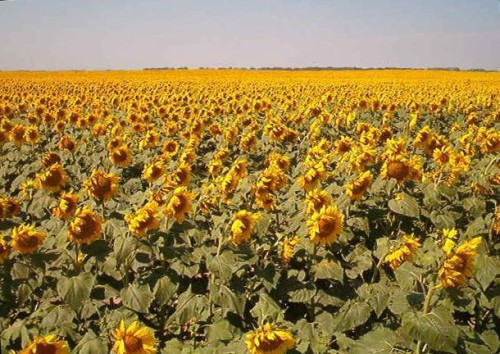TWH – For many people around the world, this week marks the celebration of the summer solstice, also known as midsummer or Litha. It is at this time that the Northern Hemisphere is tilted closest to the sun. The astrological date for this year’s solstice is June 21 at 6:07 a.m. Eastern time.
In honor of the abundance of daylight and sunshine, communities have long used bonfires, music, dancing, and outdoor festivals as traditional features of both religious rituals and secular celebrations. In some modern Pagan practices, it is believed that this holiday represents the highest ascendancy of masculine divinity.
At the same time, our friends in the Southern Hemisphere are experiencing the exact opposite. They are coming together to celebrate and mark the winter solstice; a time of darkness, candles and inward reflection.

Sunflower fields near Fargo, S.D. [Hephaestos].
June also marks gay pride month — officially proclaimed as Lesbian, Gay, Bisexual, and Transgender Pride Month — which has grown in popularity over the past few decades. Events are held during this month to mark the anniversary of the Stonewall Rebellion, which happened in New York City on June 28, 1969.
June is also the month in which many countries honor fathers and father figures and, in the U.S, it also marks the observation of Juneteenth, which celebrates the end of slavery.
While those celebrations mentioned above are all examples of secular-based traditions, there are just as many religious holidays that occur at this time, many of which are honored by modern Pagans, Heathens and polytheists. As already noted, there is the celebration of Litha or midsummer, or conversely Yule and midwinter.
The Fires of St. John festival, a Christian holiday, is also held at this time in many countries and is closely associated with the older midsummer solstice’s traditions, including bonfires and feasts. Similar celebrations are found in many European countries, often known by different names.
In Vodun, Lucumi and other African diaspora religions, there are a number of feast days celebrated around this time, including the feasts of Ochossi and Eleggua.
In modern Hellenic reconstruction, the festival of Promethea occurs on June 21. One of the traditions is to eat fennel, which this is what Prometheos used to smuggle fire to man.
Here are a few thoughts on the season:
As modern Pagans, we have multiple options for what to focus on and how to celebrate this special point in the year. Most of us probably don’t have the resources to put on a huge midsummer mystery play the way the ancient Minoans probably did at their big temples, [b]ut we can celebrate with modern-style ritual that focuses on the Minoan deities who are associated with this time of year. – Laura Perry, Summer Solstice: Celebrating Modern Minoan Paganism
Midsummer is one of the times of year — and there are several — where the fairy folk tend to be more active. Unlike other times this increased activity is generally more benevolent, although what the good people consider benevolent and what we would describe that way may not be entirely similar concepts. – Morgan Daimler, Irish-American Witchcraft: Midsummer, the Fair Folk, and Some Advice
The summer solstice is the time to acknowledge Hekate as the keeper of the keys of all creation and along our personal journey. Three contemporary ways to incorporate Hekate into solstice workings include a gratitude ritual, personal sovereignty work and seeking her assistance for shadow taming . . . . While there are many aspects of Hekate that can be incorporated into summer solstice activities and rituals, I honor her as keeper of the keys. This ancient reference from the Orphic hymn and other sources resonated deeply with me from when she first called to me. I see her as the gatekeeper of all things, from the key holder for the doors I open throughout my life’s journey to the cosmic world soul that unlocks the material world. – Cyndi Brannen, Hekate and the Summer Solstice: Suggestions for Themes, Rituals and Correspondences
On the summer solstice, the sun rises behind the Heel Stone, the ancient entrance to the stone circle, and sunlight is channelled into the centre of the monument. It is believed that solstices have been celebrated at Stonehenge for thousands of years. The site holds special significance for members of the Druid and Pagan community, who perform rituals and celebrations at the summer and winter solstices.” – BBC, Summer solstice: Thousands gather at Stonehenge for longest day
Happy solstice to all!
The Wild Hunt is not responsible for links to external content.
To join a conversation on this post:
Visit our The Wild Hunt subreddit! Point your favorite browser to https://www.reddit.com/r/The_Wild_Hunt_News/, then click “JOIN”. Make sure to click the bell, too, to be notified of new articles posted to our subreddit.
